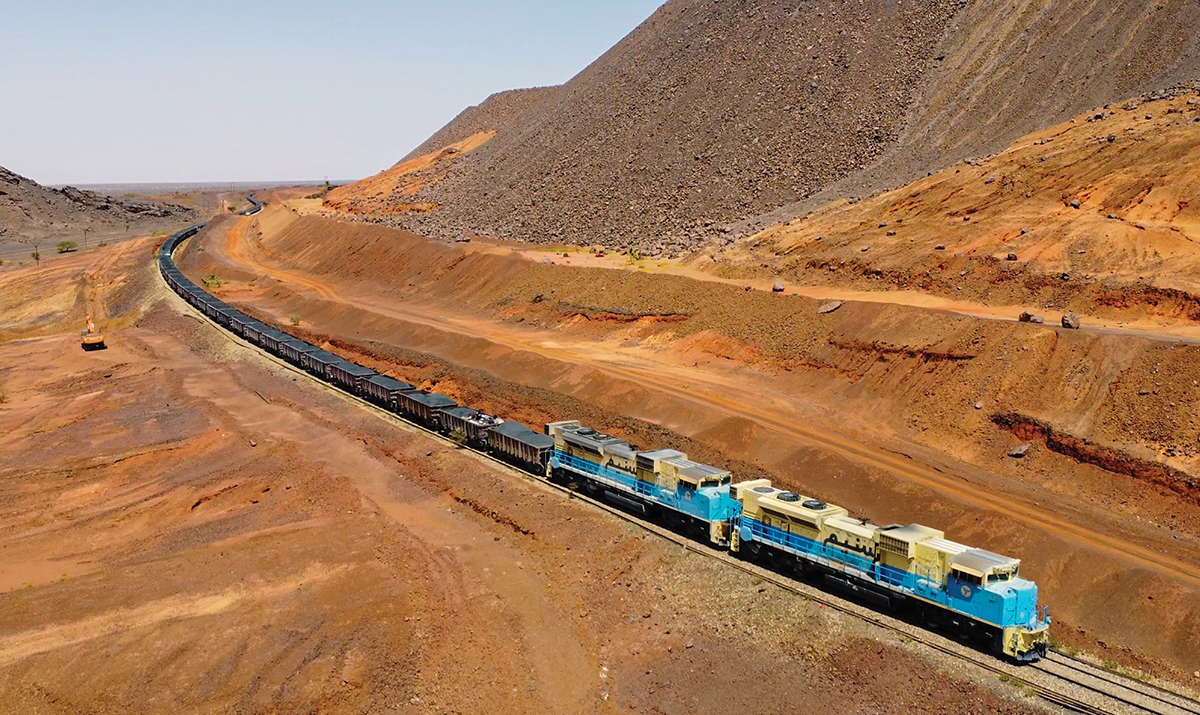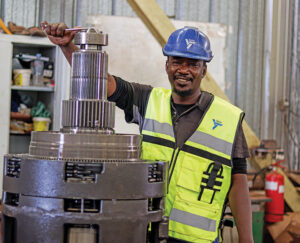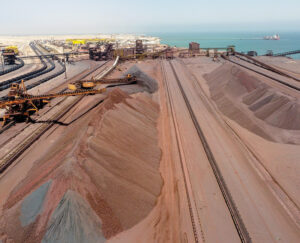
27 Nov Extracting more value from mineral reserves
With international partners, Mauritania seeks to capitalize on its mining experience, infrastructure and resources to expand the sector and decarbonize the iron and steel industry
The mining sector “is one of the main drivers of the Mauritanian economy,” asserts Mohamed Vall Mohamed Telmidy, CEO and board member of Société Nationale Industrielle et Minière (National Industrial and Mining Company/SNIM), which is responsible for the full value chain of the nation’s activities in iron ore, from geological research and mining, to processing, transport and export.
In 2022, Mauritania’s mineral resources provided 24% of the country’s gross domestic product and 60% of its exports. However, despite mining’s already substantial contribution to the economy, the country has yet to capitalize on the vast amount of resources at its disposal, according to Telmidy: “The Mauritanian subsoil is underexplored, and its mining potential is enormous and diversified.”
At present, exploitation at the country’s main mines is essentially limited to iron ore deposits by SNIM, which produced 13.35 million metric tons of iron ore in 2022, gold from Kinross’ Tasiast mine, copper from Mauritanian Copper Mines and gypsum from SAMIA, a subsidiary of SNIM. As well as boasting huge proven and untapped reserves of those minerals, including more than 10 billion metric tons of iron ore, “There are convincing indications of the existence of other minerals in Mauritania — including chromite, titanium, uranium and rare-earth elements — some of which are now the subject of exploration campaigns by national and international companies,” he says.

SNIM is the largest employer in Mauritania after the state.
The industry’s spearhead
The mining sector has always been led by SNIM, a public limited company that is 78% owned by the Mauritanian state, 22% by other local and international investors and which has 60 years of extensive experience in the extractive industry. Last year, it generated revenues of $1.26 billion and the company’s operations have made Mauritania the second-biggest producer of iron ore in Africa. “In 2022, SNIM alone contributed 22% of the state’s budget, 32% of the country’s export volumes, 9% of its GDP and we are the largest employer in Mauritania after the state, with a workforce of 6,700 people,” the CEO notes.
The company’s mining operations are based in the heart of the iron-rich Tiris Zemmour region in the north of Mauritania. After extraction, the iron ore is moved to one of SNIM’s three factories in Zouerate, the capital of the region, where it is crushed, screened and blended, or enriched to boost the iron content using magnetic separation technologies.
The ore is then transported on the company’s own railway line, which is over 430 miles long, directly to SNIM’s dedicated Atlantic-coast port at Nouadhibou, Mauritania’s economic capital. Once at the port, the ore undergoes further, finely calibrated crushing and assessment before being shipped to clients across Europe, Asia, Africa and Oceania.
While the company’s robust railway line has the capacity to carry about 65 million metric tons of ore a year, about five times its current usage level, until recently the potential for SNIM to dramatically increase its in-demand exports was limited by the berthing capacity at its port. That situation is now resolved, thanks to a $110-million expansion project co-financed by SNIM, the African Development Bank and the European Investment Bank, work on which was completed in 2021.
The Nouadhibou loading port has been widened and deepened from 53 feet to 60 feet, enabling the facility to service larger vessels of up to 230,000 metric tons. At the same time, SNIM is financing the construction of a new $15-million shipping line at the port to add flexibility and facilitate more frequent dockings and loadings. These projects will raise the company’s efficiency, global competitiveness and profitability.

The Nouadhibou loading port can service vessels of up to 230,000 metric tons.
Vital contributor to local development
Fully aware of its importance to the economic fabric of Mauritania, “SNIM has always been an economically profitable, sustainable and socially responsible company. We have been ISO 9001 certified since 2005, ISO 14001 certified since 2011 and labeled ‘Corporate Social Responsibility Committed — confirmed level’ on the Afnor certification evaluation system, which is based on the ISO 26000 standard, since 2021,” states Telmidy.
In addition to the direct financial inputs it makes to Mauritania in terms of GDP, tax revenues and salaries, the firm is a key player in developing the communities it operates in. Last year, for example, SNIM purchased goods and services to the value of $55 million from 157 diverse local businesses, which created employment for over 3,500 people.
It also contributes millions every year to social and community projects. Furthermore, he reveals, “The SNIM Foundation, which was created in 2007, has invested heavily in the areas around our mines and the Nouadhibou-Zouerate railway corridor. Our foundation intervenes in the fields of education, health, access to water and energy, local development and so on.”
The company’s focus on education extends to extensive skills training programs, both for its workforce and for other Mauritanian employers. As well as operating its own Technical Training Center at Zouerate, “We have developed partnerships with public technical training establishments to place qualified professional workers and technicians on the job market, thus contributing to the national training effort,” notes Telmidy.
When it comes to sustainability, SNIM is at the forefront of industrial decarbonization and pioneer in renewable energy generation: it installed a wind power plant at Nouadhibou as early as 2012 and is currently constructing a 12 megawatt solar facility in Zouerate. According to the CEO: “The decarbonization of our activities is a priority of our corporate strategic plan. Discussions are underway to develop a plan for decarbonization with national commitments, within the framework of the country’s greenhouse gas reduction objectives.”
Trusted partner of foreign investors
The company’s strategic development plan also focuses on significantly expanding its operations, he states: “SNIM wants to reach new levels in its production and especially in the promotion of its product. To begin with, after recording a sales record of 13.35 million metric tons of iron ore in 2022, we targeted exports of 14 million metric tons for 2023.” In the near term, the company will produce another approximately 2 million metric tons of high-quality hematite iron ore annually when its F’derick mine comes on line before the end of 2025. The F’derick mine holds ore with 60% iron content that can be extracted extremely cost effectively and, due to SNIM’s prudent financial management, it is financing the project independently.
“We have also just launched a feasibility study for a new Tizerghaf mining project, from which we aim to produce 6 million metric tons of concentrated iron ore annually. In 1984, SNIM set up its first enrichment plant to create iron ore concentrate from magnetite ore, which contains less iron than hematite, thus inaugurating a new era of primary transformation in Mauritania. Currently, almost half of our production comes from concentrate production plants,” Telmidy details.
Going forward, SNIM is building up its relationships with international partners in order to further extend its activities. The company has a long history of successful cooperative ventures with global industry players, says Telmidy: “These partnerships have allowed both parties to pool their complementary resources and experiences.” Its two largest collaborations at the moment are in the Mauritania Saudi Mining and Steel Company (Tekamul) and El Aouj Mining company (EMC). Tekamul is a 50:50 joint venture with a subsidiary of Saudi Basic Industries Corporation (SABIC), which concerns the exploitation of iron ore deposits in the Atomai area of Tiris Zemmour and their value-added conversion into high-grade direct reduction pellets. EMC, on the other hand, is a 50:50 joint venture with Switzerland’s Glencore that will extract iron ore from an open pit mine in the same region, which will then be concentrated to over 66% pure iron.
“The Tekamul project is currently in the front-end engineering design (FEED) phase, after the completion of its feasibility study, while the El Aouj project is in the funds mobilization phase, having completed its FEED stage,” updates Telmidy. “Our partnerships with Glencore and SABIC to develop iron ore beneficiation and pellet manufacturing projects have an annual capacity of 11.3 and 10 million metric tons, respectively. Our infrastructures, such as our railway and port, have the capacity to support this huge level of increase in production capacity.”
Transitioning iron and steel to net zero
As part of SNIM’s focus on decarbonization, the company is also seeking to collaborate with international specialists to maximize the benefits of Mauritania’s upcoming influx of cheap, domestically sourced natural gas and green hydrogen. Among other things, the latter fuel opens up the possibility of manufacturing large quantities of green steel for export, which would support that global industry’s transition to net zero.
“SNIM intends to take advantage of future energy solutions because they are opportunities for a profound advance in our activities and we are studying to what extent emerging solutions, such as gas or green hydrogen, can help improve the added value of our iron ore. The transformation of part of our production into pellets or green steel is one of the new directions included in our development strategy and we have already signed memorandums of understanding with Emirates Steel and ArcelorMittal to study partnership opportunities in the field of pellet and green steel production,” he reveals.
In a bid to help promote Mauritania’s industrialization, this September the company contracted the South African engineering specialist EPCM Holdings to carry out feasibility studies for a proposed 466-mile-long pipeline that will bring natural gas from the country’s offshore fields to Nouadhibou. In addition to its current cooperative ventures with international entities, “SNIM has sufficient resources and assets to seal new partnerships, whether in the exploitation of iron ore, its enrichment, its transformation or in renewable energies and the production of green steel,” Telmidy declares.
The final pillar of the company’s development strategy is diversifying its mining operations to tap into the wealth of Mauritania’s wider resources, he comments: “Within that context, in 2021 we took over a research permit for gold, copper and associated metals in the Inchiri region of northern Mauritania and the results of the research campaign we carried out there in 2022 turned out to be very encouraging.”
Telmidy would recommend international mining and energy companies to consider investing in Mauritania. “The stability of our country and its geographical position are major assets for investment and, in my opinion, Mauritania has one of the most attractive investment codes and mining codes in the sub-region. The number of active players prospecting for various minerals and other oil and gas resources is proof of the attractiveness of our country.”
The government offers investors in the mining sector numerous incentives, including a zero-rated value added tax on mining exports, while partners of SNIM may receive additional negotiated benefits — its subcontractors, for instance, are exempted from paying customs duties on any imported materials they use in their work. On top of that, Telmidy asserts, “SNIM’s weight, experience, openness to collaboration, plus its significant railway and port infrastructure, are all very favorable factors for the development of partnerships in Mauritanian mining.”
